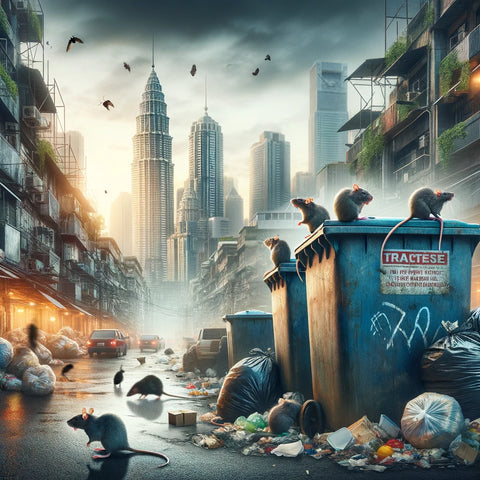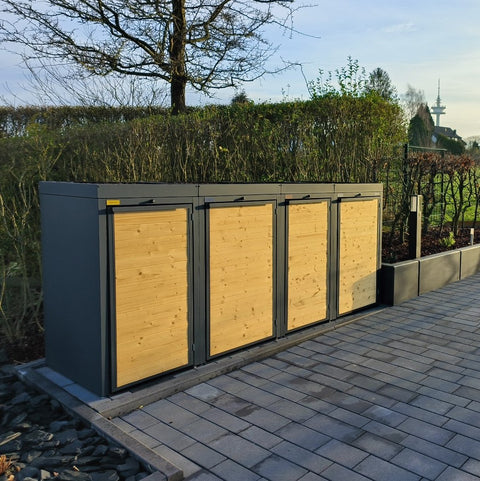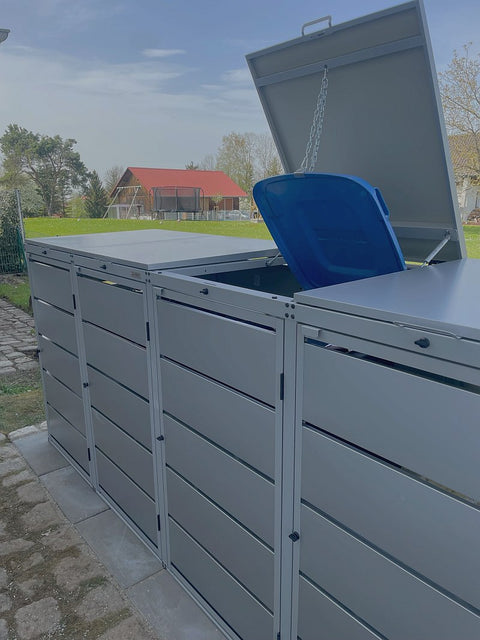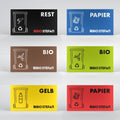In recent years, cities worldwide have observed a remarkable increase in rat and mouse populations. This phenomenon is not limited to specific regions but appears as a global problem, exacerbated by various factors, including our waste disposal habits.
Statistically, the number of rats in many major cities has doubled over the past decades. Studies, such as those by Pest Control Technology magazine, show that in cities like New York, London, and Paris, rat populations in some areas are so high that there is at least one rat per resident. These numbers are alarming, considering that rats can transmit diseases that are dangerous to humans.
But why our cities in particular? The answer largely lies in how we handle waste. Our daily produced trash offers ideal conditions for rodents. Food scraps, organic waste, and even the smallest snack left next to the bin are an invitation for rats and mice. These animals are opportunists; they use every available food source. The way we store and dispose of our waste therefore plays a crucial role in the unwanted invitation of these uninvited guests.
The worsening problem caused by garbage cannot be attributed solely to the availability of food. The structure and setup of our waste disposal systems also provide shelter and nesting places for rats and mice. Simple garbage bags or overflowing bins are not only a buffet for these animals but also a safe haven.
It becomes clear that our urban habitats and the way we handle our waste directly contribute to the proliferation of rats and mice. The good news, however, is that through more conscious disposal and better waste management practices, we can reverse this trend. Preventive measures are not only effective but also necessary to ensure health and safety in our cities.
Sources:
- Pest Control Technology Magazine: Studies on rat populations in major cities.
- Urban Pest Management Studies: The role of waste in the urban rodent problem.
By understanding the problem and taking action, we can make a significant difference. In the next part of this blog post, we will focus on exactly what such preventive measures can look like and the role products like the secure and lockable trash bin boxes developed by BIO Stefan play in this.
Why garbage attracts rats and mice
Unsecured waste is like a beacon for rats and mice. These rodents are constantly searching for food and a safe place to nest. Our waste products offer both in abundance, making our urban and rural areas a paradise for these pests.
The direct connection between unsecured waste and the attraction of rats and mice is well documented. Studies show that rats are particularly attracted to organic waste such as food scraps found in our trash bins and landfills. Mice, although smaller, are equally skilled at gaining access to our waste and feeding on it. The availability of food is a major factor that directly influences the survival and reproduction rates of these pests.
In addition to the food source, piles of garbage and unsecured trash bins also provide ideal hiding places and nesting sites for rats and mice. The garbage offers protection from predators and insulation for their nests, which is vital for survival in an urban environment. A study by Urban Pest Management has shown that rats are able to nest in unsecured waste containers and establish colonies there, which are then difficult to eliminate.
The attraction of garbage to rats and mice is only intensified by our often careless waste disposal. Overflowing trash bins, loose garbage bags, and even compost piles can unintentionally become an invitation for pests. This fact underscores the need to carefully secure and dispose of waste to minimize the presence of rats and mice.
Sources:
- Urban Pest Management: "The Impact of Urban Waste on Rat Populations".
- Environmental Health Perspectives: "Waste Management and Pest Control".
By understanding these dynamics, we can take more targeted measures to make our environments less inviting for rats and mice. In the next section, we will look at effective prevention measures that can help combat this problem.
Prevention tips against waste problems
To effectively address waste problems and minimize the attraction for rats and mice, it is crucial to adopt proven prevention measures. These tips are not only easy to implement but also significantly contribute to making our environment cleaner and safer.
1. Use regular garbage collection and optimize waste separation
A key to avoiding pest problems lies in regular garbage collection and effective waste separation. By ensuring that our waste is disposed of on time and correctly separated, we reduce the chances of food sources accumulating for rats and mice. Organic waste should be disposed of in tightly sealed bio bins to prevent odors from escaping and attracting pests. Optimizing waste separation also helps improve recycling processes and reduces the amount of waste that serves as a potential food source for rodents.
2. Improve hygiene around waste disposal sites
A clean and hygienic environment around waste disposal sites is essential to keep rats and mice away. Regular cleaning of these areas, including the floor and walls around garbage containers or bins, minimizes the attraction for pests. It also prevents the accumulation of food residues or other waste that could serve as a food source.
3. Store waste properly to minimize odors
Proper storage of waste is crucial to minimize unwanted odors that could attract rats and mice. Waste containers should be securely closable to make access difficult for pests and to contain odors. The use of garbage bin boxes, especially made of metal, offers additional protection. Such boxes are not only robust and resistant to rodent intrusion but also an aesthetically pleasing solution that ensures safety and cleanliness.
By implementing these prevention tips, the problem of garbage, rats, and mice can be significantly reduced. The measures not only contribute to a safer and healthier environment but also support sustainable waste management practices.
The role of the trash bin box in pest prevention
In both urban and rural environments, the attraction of pests by improperly secured waste is a serious problem. Rats and mice find not only a rich food source but also shelter in human waste products. An effective solution to these challenges is the metal trash bin box. Its role in pest prevention should not be underestimated, as it combines security with functionality and significantly contributes to hygiene and order in public and private spaces.
Effective solution: metal trash bin box
The metal trash bin box represents a robust and durable solution to securely store waste and effectively repel pests. Unlike trash bins that stand freely and are easily accessible, such a box offers a lockable and thus secure storage place. Due to its stable construction, it can withstand pests' attempts to gain access.
Advantages of a lockable and secure trash bin box
Prevents tipping over and opening of binsA key advantage of the metal trash bin box is its ability to prevent tipping over and unwanted opening of trash bins. Strong gusts of wind or animals searching for food can easily knock over open or unstable trash bins, resulting in waste spreading and attracting pests. A lockable trash bin box counters this and ensures that the waste remains securely stored.
Protects against pest accessibility
Due to its construction and material, the metal trash bin box is particularly effective at keeping pests away. Rats, mice, and other animals cannot enter such a box because they cannot bite through the material or open the locks. Thus, access to potential food sources is effectively blocked.
The role in pest prevention
Preventing pest problems through a trash bin box goes beyond merely securing waste. It significantly contributes to cleanliness and hygiene in outdoor areas by preventing waste from spreading and attracting pests. This is especially important in densely populated urban areas where space is limited and hygiene plays a central role.
German sources and expert opinions
According to a study by the German Pesticide Action Network (PAN Germany), preventing pests through proper waste disposal and securing is an important step in reducing the use of pest control agents. Experts emphasize that physical barriers, such as those provided by a metal trash bin box, are one of the most effective methods to prevent pest infestations.
Furthermore, environmental and health authorities regularly emphasize the importance of waste hygiene. In their guidelines for pest prevention, the use of secure and lockable waste containers is often cited as a basic requirement.
BIO Stefan's Solution: The Metal Trash Bin Box
In today's world, where sustainability and environmental protection are at the forefront of societal efforts, BIO Stefan presents an innovative solution that not only meets these ideals but also addresses a pressing problem for modern households and businesses: the safe and hygienic storage of waste. We are talking about the metal trash bin box, a product that combines design and functionality, thus providing an answer to the challenges that waste brings in connection with rats and mice.
Design Meets Functionality
BIO Stefan's metal trash bin box is a prime example of how aesthetic demands can be merged with practical necessity. With a modern, appealing design, it blends seamlessly into any environment—whether in a private garden or the outdoor area of a business. But the box impresses not only with its appearance; its construction is well thought out and aims to revolutionize waste storage.
Solution for Waste Problems and Pest Control
Using such a box effectively solves the fundamental problems associated with improper waste storage. The robust metal and lockable doors provide a secure storage place protected from access by rats and mice. The animals, attracted by the smell of the waste, find no way inside, significantly reducing the risk of pest infestation. Additionally, the sturdy construction prevents the bins from tipping over, even in strong winds or accidental bumps, further supporting cleanliness and order in outdoor areas.
Sustainability and Durability
Another aspect that highlights the metal trash bin box from BIO Stefan is its sustainability. Unlike solutions made of plastic or wood, which can quickly wear out due to environmental influences, the metal box is characterized by exceptional durability. Metal is resistant to weathering, corrosion, and other damage, which means the box serves its purpose for many years, if not decades, without needing replacement. This not only helps reduce waste by requiring less material disposal but also represents a cost-effective investment.
The production of the boxes is carried out with ecological principles in mind. BIO Stefan emphasizes using materials that are recycled or sustainably sourced and pays attention to energy-efficient manufacturing processes. Thus, the metal waste bin box stands not only for a direct solution in the fight against pests and disorder but also for a contribution to environmental protection.
Conclusion
With the metal waste bin box, BIO Stefan offers a comprehensive answer to the issues surrounding waste, rats, and mice. By combining thoughtful design, high functionality, and sustainability, the product sets new standards in waste management. It is an investment in a clean, safe, and environmentally friendly future that demonstrates how innovative thinking and action can solve practical problems while contributing to the protection of our planet.
The increasing presence of pests caused by improper waste disposal is a problem that urgently needs to be addressed. Preventive measures are not only crucial for maintaining public health and safety but also play an essential role in protecting our environment. By implementing effective solutions like the metal waste bin box from BIO Stefan, we can take a significant step toward a more sustainable and safer future.
This innovative solution combines design with functionality to effectively address the challenges posed by waste, rats, and mice. The durability and sustainability of the metal waste bin box make it an ideal choice for anyone who values an environmentally friendly and long-lasting solution. Securing waste in such a box not only minimizes the risk of pest infestation but also promotes cleanliness and order in our living spaces.
It is time to take responsibility for our environment and implement preventive measures against waste problems and the associated pests. I warmly invite you to learn more about the thoughtful and sustainable solutions from BIO Stefan at bio-stefan.at. Let us decide together for a clean, safe, and green future where pests have no chance to endanger our health and well-being. Choosing a metal waste bin box from BIO Stefan is a step in the right direction – for us and our planet.




